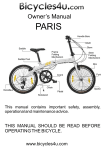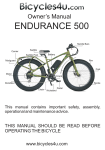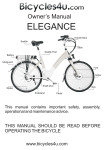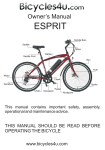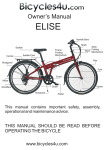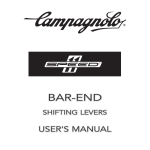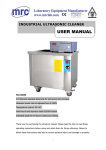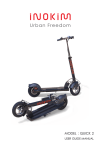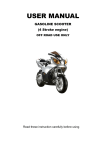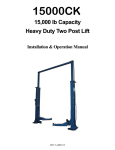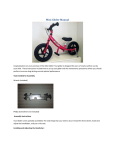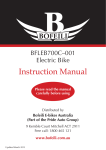Download PRAGUE - Shopify
Transcript
Owner’s Manual PRAGUE Handle Bars Saddle Frame Folding Mechanism Saddle Post Stem Rim Crank Fork Spoke Derailleur Chain Pedal This manual contains important safety, assembly, operational and maintenance advice. THIS MANUAL SHOULD BE READ BEFORE OPERATING THE BICYCLES. www.bicycles4u.com User Security 1) Do not operate the bike before reading this user manual thoroughly. The manufacturer will not be held responsible for any damage or accident due to improper use. 2) For your safety and others please follow the traffic regulations. This bicycle is not suitable for children under thirteen and the physically challenged. This bicycle is not recommended for competition, stunts or off-road riding. 3) Do not lubricate the brakes. 4) The braking length of a dry state surface/road is 4 meters at 25km/h, while 15 meters in wet state. So move slowly, keep a safe distance from other vehicles/objects around you and brake in advance where necessary while riding downhill, in rain, snow & wet road. 5) To ensure your safety please use helmets, check the brakes & tyres, handlebars and rims before riding. 6) Maximum rider weight : 125 Kg. Maximum carrier weight : 15 Kg. 7) Improper use could cause harm, please check the connection of the frame, stem and suspension periodically. Every mechanical part has friction and pressure, different materials and parts have different frictions and pressures. If a mechanical part has exceeded its service life, resultant damage could hurt the user. Regular check’s for safety before riding 1) Check if the handlebar stem and saddle post are safely inserted. 2) Check the brake shoes for excess wear, If there is you should replace them before riding. 3) Check if the nuts on the front and rear axis are securely fixed. 4) Check pedals and other fixtures for any signs of damage. Check if rotary parts move freely 6) Check the tyre pressure in accordance with the markings and check for ample treads on the tyre. If they are excessively worn replace them immediately. 7) Make sure that you know how to operate the bike and clearly know all the traffic regulations. Step by Step instructions for folding and assembling Steps to fold the bike 1) Loosen the screw that is shown below using an allen key (for handlebar stem). 2) Remove the handlebars. 3) Pull the trigger of the pedal and fold it downwards simultaneously. 4) Loosen the quick release then pull it backwards and pull it up to release the lock mechanism. 5) Fold the bicycle inwards 6) Finished 1-2 3 4 5-6 Steps to unfold the bike 1) Unfold the front and rear frame. 2) Lock the frame folding mechanism. 3) Place the handlebars inside the tube and tight them in securely. 4) Pull the trigger of the pedal and unfold the pedal upwards simultaneously. 5) Finished. General Maintenance Remarks Adjusting the height of the saddle In order to adjust the height of the saddle you’ll have to unlock the lever that can be seen in the pictures below, adjust the saddle height to the desired position without exceeding the mark carved onto the saddle’s tube. Lock the lever in place and you’re done. The saddle’s height must be set so that you can place your feet at the ground comfortably. Cleaning and Maintenance Regular maintenance guarantees you a longer durability and road worthy state of your bike. Maintenance includes cleaning, lubricating and ride setting adjustments. Regular maintenance work is required to sustain a warranty claim. This applies to special corrosion (surface rust) and other damages, which by non-observance, would not be undertaken by us. Thus, please read through the following section thoroughly. Frequency Weekly Monthly Every Six Months Yearly Lubrication Component Chain Derailleur Pulleys Derailleurs Brake Calipers Brake Levers Shift Levers Freewheel Brake Cables Bottom Bracket Pedals Derailleur Cables Wheel Bearings Headset Seat Post Lubricant Chain Lube or Light Oil Chain Lube or Light Oil Oil Oil Oil Lithium Based Grease Oil Lithium Based Grease Lithium Based Grease Lithium Based Grease Lithium Based Grease Lithium Based Grease Lithium Based Grease Lithium Based Grease How to Lubricate Brush On or Squirt Brush On or Squirt Oil Can 3 drops from oil can 2 drops from oil can Disassemble 2 squirts from oil can Disassemble Disassemble Disassemble Disassemble Disassemble Disassemble Disassemble Chain The chain must be regularly (especially after riding in the rain) lubricated with a standard chain-caring product. Physical stretching of the chain requires checking procedures to be carried out to ensure that the tension is adequate. Examine the chain tension by positioning the bike on its kickstand and test whether the chain, while being pushed upwards or downwards has a maximum gap of 10-15 mm in between. If this is not the case please proceed to the following steps: !) Loosen the axle nuts on both sides of the wheel and the brake counter - bracket (for the back pedalling brake) on the left side of the rear - end stay. Where a gearbox removal is required please see the manufacturer’s instruction manual . 2) Subsequently, adjust the chain’s tension by turning the tension screw nuts on both the left and the right sides. 3)Before tightening of the axle nuts, check whether the wheel stands in the centre and adjust if needed. 4) Tightly screw the axle nuts and the tension screw nuts. (Tightening Torgue not less than 30N-M) 5) Recheck the chain tension An over-tightened chain can cause pops during riding. Adjust the derailleur Adjust the Fine-tuning nut or screw when the derailleur makes some abnormal sound. The way to adjust the brake of the bike is the same as adjusting the gears. The most important thing is effective braking and releasing of the brake pads and the power brake function work well together. Friction between road and tyre is reduced when raining, so every rider should brake gently in order to avoid danger. Please follow the several bits of advice given, every screw and nut should be tightened properly to make sure the wheel is running freely with no resistance Brakes The brake-shoes which are fixed on the V-brake and Roller-brake wear out in time causing gap widening between the brake-shoes and the rim flank. This is indicated by the increase of the leeway of the brake lever The left brake lever controls the rear and the right brake lever controls the front brake. You can modify by adjusting the brake system through the following steps: Simply turn the adjusting screw on the brake lever until the gap between the brake shoes and the rim flank averages about 1.5-2 mm. Adjust the brakes correctly by tightening or loosening the crosshead screws on the side of the brake arms, until the brake shows are centered to the rim. Through tightening of the screws, the spring will be prestressed and the brake-shoe will move away from the rim. Warranty NAME Frame Front Fork Handlebar, Stem and Accessories Spindle and Parts Seat Post Transmission, Shift Lever and Brake Lever Rim Shaft skin, Flywheel, Gear, and Crank Chains, Mudguard, Hanger and Kickstand FAULT Fracture, sealing off, or open solder Fracture, sealing off, or open solder Fracture WARRANTY PERIOD one year Heat treatment parts damaged or broken Fracture Fracture, broken one year Cracking Fracture one year one year Fracture one year one year one year one year one year When does the warranty not apply? ? When the bicycle is used negligently or has damage resulting from a traffic accident. ? Normal wear and tear. ? Poor maintenance or modifications that no longer comply with regulations or original specifications. ? Damage due to external causes. ? When the bicycle is used for rental. ? Compensatory costs arising from damages or accidents, or cost incurred by loss of the bicycle’s usage. ? Bulbs, brake blocks, tyres etc. - Are regarded consumables, therefore when replacements are required, these need to be purchased from your local cycle shop or store.




